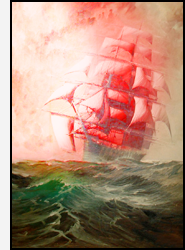Almost Hit by a Meteor
From Earth, Sea and Sky by Henry Davenport Northrop, 1887
(Illustration after Reo Langauer, date unknown)
 A remarkable story is related by Captain C.D. Swart, of the Dutch bark, J.P.A. The Captain thinks that his theory, derived from a recent experience, will account for the sudden disappearance of many vessels at sea. He says that March 19, 1887, his ship, while in latitude 37° 39' and longitude 57° west, met a heavy storm. At about five o'clock in the afternoon a meteor was observed flying through the air.
A remarkable story is related by Captain C.D. Swart, of the Dutch bark, J.P.A. The Captain thinks that his theory, derived from a recent experience, will account for the sudden disappearance of many vessels at sea. He says that March 19, 1887, his ship, while in latitude 37° 39' and longitude 57° west, met a heavy storm. At about five o'clock in the afternoon a meteor was observed flying through the air.
It looked like two balls, one very black and the other brightly illuminated. The latter fell, and as it seemed that it would strike the vessel she was hove to under storm sails. The meteor dropped into the sea close along side, making in its flight a tremendous roaring noise. Before reaching the water, the upper atmosphere was darkened, while below and on board everything appeared like a sea of fire. The force of the meteor in striking the water caused heavy breakers, which washed over the vessel, making her roll in a dangerous manner. At the same time the atmosphere became uncomfortably warm and the air was full of sulphur. Immediately after this, solid lumps of ice fell on deck, and everything on deck and in the rigging became iced, notwithstanding that the thermometer registered 19° Centigrade (66° f).
The barometer during the phenomenon oscillated so violently that no reading could be taken. After close examination of the vessel and rigging no damage was found on deck, but on the side where the meteor fell into the water the ship appeared all black and some of the copper sheathing was blistered.

